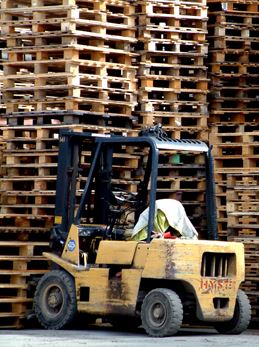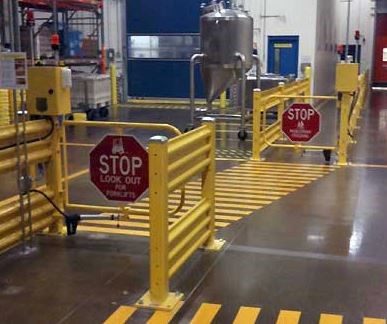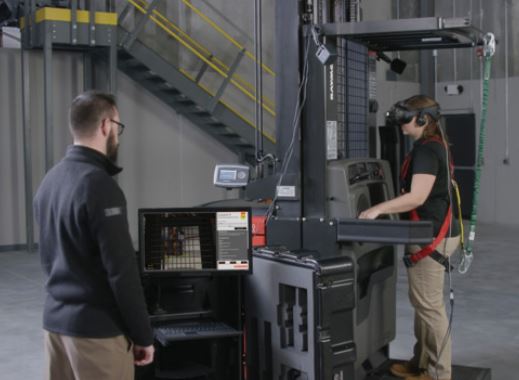I recently attended a Raymond Roadshow event and had the opportunity to try Raymond’s patented Virtual Reality training tool. It helps operators get up to speed (no pun intended) on driving various types of lift trucks, quickly gaining proficiency and taking into consideration all safety precautions. I even got to experience the vertigo when elevating an order picker and doing case picking. Although I scored well on that part of the process, I found myself disappointed in my safety score and I didn’t even have the experience of reacting to pedestrians walking through the warehouse, which would have been an even more dynamic challenge. It’s a tool that may revolutionize lift truck operator screening and training.
 Every year in North America there are nearly 70,000 forklift accidents and incidents. This is a number that should be easily reduced with increased awareness and proper training. There is little doubt that with everyone pushing for greater warehouse efficiencies, the speed/productivity envelope is being pushed and this is not likely to change in the foreseeable future, particularly considering the boon in E-commerce alone. So, training is all that much more important.
Every year in North America there are nearly 70,000 forklift accidents and incidents. This is a number that should be easily reduced with increased awareness and proper training. There is little doubt that with everyone pushing for greater warehouse efficiencies, the speed/productivity envelope is being pushed and this is not likely to change in the foreseeable future, particularly considering the boon in E-commerce alone. So, training is all that much more important.
There is another side of this coin for which there needs to be a strong, unwavering focus. If you work in the warehouse industry, you know that the Occupational Safety and Health Administration (OSHA) requires that all forklift drivers be trained on each piece of equipment he or she will be operating. However, what many warehouse managers fail to  realize is the importance of training pedestrians to be cognizant of the danger and the potential for accidents when they are walking around in a fast-paced environment where lift trucks are being operated. It’s also imperative for operators to respect and be aware of the potential for pedestrian traffic in the warehouse. We know about pedestrian walkways, but I have personally witnessed operators driving through them as well as those who unwittingly walk outside the lines. More than a couple of times I have seen drivers fly through blind corners and forget to look or beep in an audible warning.
realize is the importance of training pedestrians to be cognizant of the danger and the potential for accidents when they are walking around in a fast-paced environment where lift trucks are being operated. It’s also imperative for operators to respect and be aware of the potential for pedestrian traffic in the warehouse. We know about pedestrian walkways, but I have personally witnessed operators driving through them as well as those who unwittingly walk outside the lines. More than a couple of times I have seen drivers fly through blind corners and forget to look or beep in an audible warning.
I am getting more and more requests for guard rails, blue firefly lights, mirrors, etc., all for  the purpose of mitigating the potential for an incident. Incidents cost time and money, and potentially a life. The workplace will be a more efficient and productive environment when pedestrians and forklift operators are trained and they both take note of warehouse signage. When employees are educated, the number of forklift accidents can be reduced.
the purpose of mitigating the potential for an incident. Incidents cost time and money, and potentially a life. The workplace will be a more efficient and productive environment when pedestrians and forklift operators are trained and they both take note of warehouse signage. When employees are educated, the number of forklift accidents can be reduced.
Top five forklift safety tips for pedestrians working with forklifts:
- Use dedicated pedestrian walkways: Pedestrian walkways are similar to sidewalks and crosswalks found on our streets and roads.
- Stop, look and listen for oncoming traffic: Forklift operators are trained to honk the lift truck’s horn when crossing an intersection, when going around corners, and whenever their vision might be obstructed. Be aware of these sounds.
- Make eye contact with drivers: Just like everyday vehicles, forklifts have blind spots. When you make eye contact with drivers, this ensures that the operator is aware of your presence.
- Know that a truck needs adequate time to stop: Forklifts are very heavy pieces of equipment that are designed to carry heavy loads. Likewise, lift trucks are not designed to stop suddenly. Rather, they are designed to minimize the damage to the load and to maintain stability.
- Stand clear of lift trucks in operation: One of the forklift operator’s jobs is to keep the product from being damaged. Therefore, the operator might be focused on the pallet load and not aware of a person standing around the lift truck.
Top five forklift safety tips for forklift operators to abide by:
- Give pedestrians the right-of-way: Always stop when pedestrians walk across your planned route. Wait until the person or people have passed by and continue cautiously through any congested area.
- Never drive close to anyone: If there is not enough space to travel, warn pedestrians and ask them to move.
- Look in the direction of travel: If there is not a clear view, do not move the lift truck.
- Stop and sound the horn when approaching an intersection, crosswalk or exiting an aisle: Warn pedestrians and other forklift operators that a forklift is coming.
- Approach and leave aisles slowly: Drive cautiously and use alarms when entering and exiting warehouse aisles.
When forklift operators and pedestrians work in tandem in the warehouse, it will help to keep everyone safe. It’s important that both groups know and follow the rules. It’s also important for warehouse managers to enforce those rules.
Have a safe and productive day!



Leave a Reply
You must be logged in to post a comment.